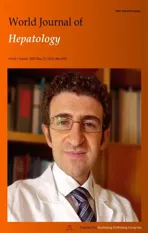Reply to "Six-minute walking test performance is associated with survival in cirrhotic patients" to the editor
2022-11-28CarlaMalagutiCarlosAlbertoMourJuniorlioMariaChebli
Carla Malaguti,Carlos Alberto Mourão-Junior,Júlio Maria Chebli
Carla Malaguti,Departament of Cardiorespiratory and Skeletal Muscle,Universidade Federal de Juiz de Fora,Juiz de Fora 36036-634,Minas Gerais,Brazil
Carlos Alberto Mourão-Junior,Department of Physiology,Universidade Federal de Juiz de Fora,Juiz de Fora 36036-634,Minas Gerais,Brazil
Júlio Maria Chebli,Department of Medicine,Universidade Federal de Juiz de Fora,Juiz de Fora 36036-634,Minas Gerais,Brazil
Abstract Use of the six-minute walk test has been proposed as a prognostic marker in liver cirrhosis.In the Letter to the Editor presented here,the authors highlight some important points,which were raised after the article was published in the November issue of the World Journal of Hepatology.
Key Words: Six-minute walking test;Liver cirrhosis;Hospital admission and mortality
TO THE EDlTOR
The six-minute walk test(6MWT)is an easy-to-perform,inexpensive,and highly reproducible test to assess exercise capacity[1-3].It also provides the most comprehensive prognostic information on many chronic health conditions[1].Recently,our research group showed the prognostic clinical value of 6MWT in regard to predicting the risk of clinical decompensation in patients with compensated cirrhosis,adding clinical prognostic value in the evaluation[4].
In the November issue of theWorld Journal of Hepatology(WJH),Pimentelet al[5]reported the predictive capacity for mortality in patients with liver cirrhosis using the distance covered in the 6MWT over a 1-year period.The interesting results of that study seem to be in line with findings from other populations,in which the distance covered in the 6MWT predicts mortality and decompensation[6,7].It must be noted that the study of Pimentelet al[5]was conducted in Brazil,and the reference equation used to determine predicted values of distance covered in the 6MWT was proposed by Enrightet al[8]and based on a North American(United States)population.
The 6MWT is better interpreted if reference values are obtained using equations developed using a sample from the same country.Different authors have proposed reference values to predict the expected "normal" distance to be covered by a given patient[8-13].Moreover,many equations with similar predictors are available in Brazil[10-13],despite different coefficients of determination.Negreiroset al[14]compared six reference equations developed in Brazil and observed that the equation proposed by Brittoet al[13]estimated the most accurate results of distance covered by healthy Brazilian men.This is particularly relevant because Machadoet al[15]demonstrated a low agreement between the reference equations of Enrightet al[8]and Brittoet al[13](Kappa = 0.39).
Furthermore,studies carried out in different countries with healthy adults and older adults showed that the amount and intensity of physical activity vary considerably,depending on several factors,such as ethnicity,education level,and socioeconomic level[16,17].In the study by Pittaet al[18],Brazilian patients with chronic obstructive pulmonary disease had a higher level of physical activity in daily life than Austrian patients,despite the high prevalence of comorbidities in Brazilian patients(e.g.,hypertension,diabetes,and osteoporosis).These results suggest that socioeconomic status and ethnic predictors for physical inactivity play a different role in inactive populations;for instance,South American patients are more active than patients in Central Europe due to worse socioeconomic conditions;they also have a higher degree of ethnic miscegenation.These factors certainly impact exercise capacity during the 6MWT.And as a result of this impact,using a reference equation in a given population is crucial.
We congratulate Pimentel and colleagues for their important contribution regarding the predictive capacity of distance covered in the 6MWT for mortality of patients with liver cirrhosis.However,considering the statements reported herein,it seems reasonable to recommend using available reference equations based on a national study.
FOOTNOTES
Author contributions:Malaguti C,Mourão-Junior CA,and Chebli JM were responsible for the conception,interpretation of the data,making critical revisions and final approval of the version of the article to be published;All authors of this manuscript contributed to its development.
Conflict-of-interest statement:The authors declare having no conflicts of interest.
Open-Access:This article is an open-access article that was selected by an in-house editor and fully peer-reviewed by external reviewers.It is distributed in accordance with the Creative Commons Attribution NonCommercial(CC BYNC 4.0)license,which permits others to distribute,remix,adapt,build upon this work non-commercially,and license their derivative works on different terms,provided the original work is properly cited and the use is noncommercial.See: https://creativecommons.org/Licenses/by-nc/4.0/
Country/Territory of origin:Brazil
ORClD number:Carla Malaguti 0000-0002-6619-136X;Carlos Alberto Mourão-Junior 0000-0001-7199-5365;Júlio Maria Chebli 0000-0003-1527-0663.
S-Editor:Liu JH
L-Editor:A
P-Editor:Liu JH
杂志排行
World Journal of Hepatology的其它文章
- Role of biliary complications in chronic graft rejection after living donor liver transplantation
- Role of hepatitis Β virus in development of hepatocellular carcinoma:Focus on covalently closed circular DNA
- Emerging curative-intent minimally-invasive therapies for hepatocellular carcinoma
- Saving time and effort: Βest practice for adapting existing patientreported outcome measures in hepatology
- Loco-regional treatment of hepatocellular carcinoma:Role of contrast-enhanced ultrasonography
- Βenign focal liver lesions:The role of magnetic resonance imaging
